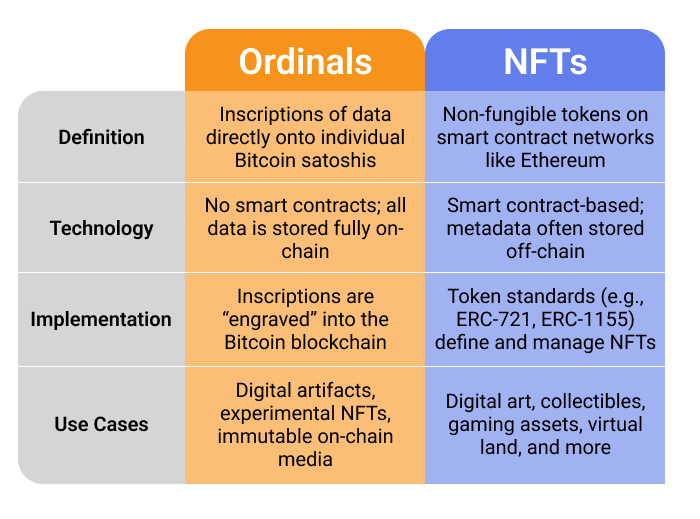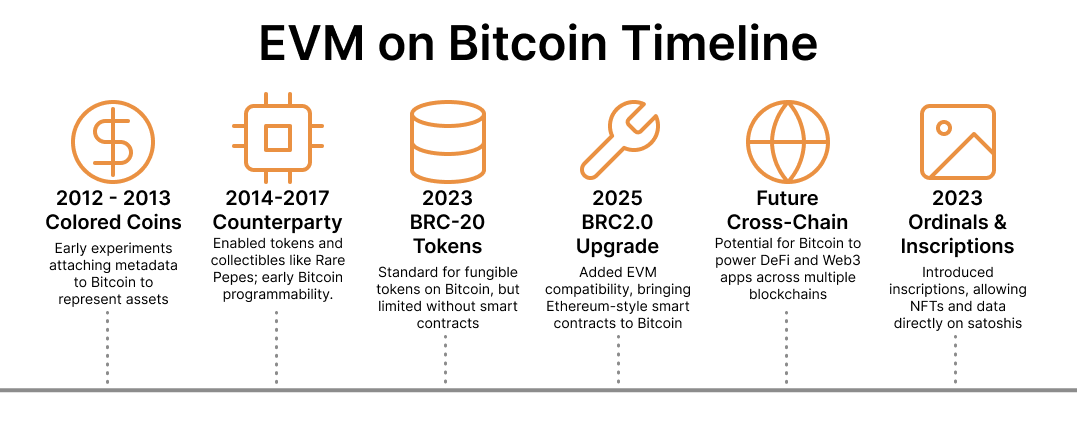When most people think about Bitcoin, they think of it as digital gold — a secure, decentralized store of value. Unlike Ethereum, which was designed from the start with smart contracts in mind, Bitcoin was not originally built for programmable applications. Still, developers have long been interested in expanding Bitcoin’s functionality to include tokens, contracts, and even decentralized applications (dApps). That journey has been full of experimentation, technical hurdles, and new innovations.
Early Attempts at Programmability on Bitcoin
Bitcoin’s scripting language is intentionally limited, prioritizing security and simplicity over flexibility. When Bitcoin was created, the primary goal was to serve as a secure, decentralized payments network, enabling peer-to-peer transfers without relying on banks or intermediaries. Its design focused on preventing double-spending, ensuring transaction integrity, and maintaining consensus across a distributed network, rather than supporting complex smart contracts or decentralized applications.
Early efforts, such as Colored Coins (2012–2013), attempted to represent tokens on Bitcoin by attaching metadata to small transactions. The goal was to issue and track custom assets—like company shares, loyalty points, or digital collectibles—directly on Bitcoin’s blockchain. Importantly, this experimentation predates Ethereum, showing that Bitcoin developers were exploring tokenization and programmable assets long before smart contracts and ERC-20 tokens became popular.
From 2014–2017, the Counterparty protocol further explored Bitcoin programmability, enabling the creation of tokens and digital collectibles, such as the famous Rare Pepes. These projects demonstrated the demand for more advanced features on Bitcoin, but Counterparty remained relatively complex and relied heavily on Bitcoin’s limited scripting capabilities, which constrained more sophisticated applications.
The Rise of Ordinals and BRC-20
A major turning point came in 2023 with the introduction of Ordinals, a protocol that allowed users to “inscribe” data, such as images, text, or other digital artifacts, directly onto individual satoshis (the smallest unit of Bitcoin). This opened the door to Bitcoin NFTs and a wave of experimentation on-chain.
Building on this, developers created the BRC-20 token standard — inspired by Ethereum’s ERC-20 — which enabled the creation and transfer of fungible tokens on Bitcoin using Ordinals inscriptions. BRC-20 tokens quickly became popular, fueling a surge in on-chain activity.
However, BRC-20 was limited. Tokens were essentially metadata tracked by off-chain indexers, with no native smart contract support. Unlike true smart contracts, which can automatically execute rules, enforce conditions, and interact with other applications on-chain, BRC-20 tokens had no built-in logic or programmability. This meant they couldn’t support features like decentralized exchanges, lending protocols, or automated governance. Instead, their functionality depended heavily on third-party services interpreting inscriptions, making them more like experimental proofs of concept than fully integrated assets. Functionality was basic compared to Ethereum’s ERC-20 ecosystem, and scaling was difficult since Bitcoin’s block space is scarce and expensive.

BRC2.0 and the Push for EVM on Bitcoin
In 2025, the community introduced BRC2.0, a major upgrade that goes beyond simple token issuance. Unlike BRC-20, BRC2.0 is designed to bring Ethereum Virtual Machine (EVM) compatibility to Bitcoin. The pseudonymous creator of BRC-20, Domo, and the Ordinals Infrastructure firm Best in Slot collaborated to create the BRC2.0 upgrade.
With this upgrade, developers can now deploy and interact with smart contracts on Bitcoin in ways that weren’t possible before. BRC2.0 enables contracts written for Ethereum to run directly on Bitcoin, opening the door to DeFi applications, NFTs, DAOs, and other advanced dApps. It also provides a bridge for Ethereum developers to tap into Bitcoin’s unmatched security and liquidity without reinventing their tools and codebases.
The key difference is that while BRC-20 was primarily a token experiment, BRC2.0 represents a platform shift, positioning Bitcoin as a potential competitor to established smart contract platforms like Ethereum, Solana, and Avalanche.

Challenges and Trade-Offs
While the idea of EVM on Bitcoin is exciting, it is not without challenges.
Scalability remains one of the most pressing concerns. Bitcoin was never designed for complex contract execution, and adding that functionality could introduce performance bottlenecks that limit adoption. Over the years, Bitcoin has explored several solutions to address scalability without fundamentally changing its core protocol. One of the most prominent is the Lightning Network, a Layer-2 payment protocol that allows off-chain transactions to occur instantly and with minimal fees, easing congestion on the main chain. Other approaches include Segregated Witness (SegWit), which increases block capacity by separating signature data, and various batching and compression techniques that optimize transaction throughput. While these innovations improve Bitcoin’s ability to handle more transactions, they are primarily focused on payments and do not directly solve the challenges of executing complex smart contracts at scale.
There are also significant security risks. Expanding Bitcoin to run EVM logic increases the potential attack surface, raising questions about whether it could weaken Bitcoin’s security model or expose it to vulnerabilities that Ethereum and other smart contract platforms have already grappled with. Bitcoin’s robust security has been central to its reputation as “digital gold”, attracting investors who value a highly resilient, censorship-resistant store of value. Any compromise to this security could not only endanger individual assets but also undermine the network’s credibility and its fundamental value proposition.
Finally, there is the question of community consensus. Some Bitcoin purists argue that programmability is a distraction from Bitcoin’s core role as a secure, censorship-resistant currency and worry that expanding functionality could threaten the network’s foundational security. Others, however, see smart contracts as a natural evolution that could expand Bitcoin’s utility while carefully preserving its security and core principles, ensuring that the network continues to function as a reliable store of value and trusted settlement layer.

What’s Next for Bitcoin Smart Contracts?
The introduction of BRC2.0 signals a new chapter for Bitcoin. Developers may soon begin experimenting with a broader range of decentralized applications, from DeFi protocols to stablecoins and gaming platforms, directly on the Bitcoin network. If adoption grows, Bitcoin could evolve from being primarily a store of value into a programmable ecosystem.
Another likely development is greater cross-chain interoperability. With EVM compatibility, Bitcoin has the potential to integrate more seamlessly into the wider Web3 world, allowing liquidity and applications to flow between blockchains more easily. This could strengthen Bitcoin’s position as both a secure asset and a hub within the multi-chain ecosystem.
Still, the future depends on community consensus and adoption. The Bitcoin ecosystem has always been cautious about change, and the balance between innovation and conservatism will play a key role in shaping whether smart contracts on Bitcoin truly take off.
From Colored Coins to Ordinals, BRC-20, and now BRC2.0 with EVM support, Bitcoin’s journey toward programmability has been marked by experimentation and debate. While challenges remain, the possibility of running Ethereum-style smart contracts on Bitcoin could reshape how the world’s largest blockchain is used in the future — transforming it from a passive asset into a foundation for decentralized applications.
Thank you for checking out our article on Smart Contracts and Tokens on Bitcoin! Don't forget to download Enkrypt for a seamless web3 multichain wallet experience. We would love to hear from you on our social media about any guide suggestions you have for the future. Also, if you enjoy using mobile cryptocurrency wallets, give our MEW Mobile app a try, it's available on both iOS and Android platforms!

